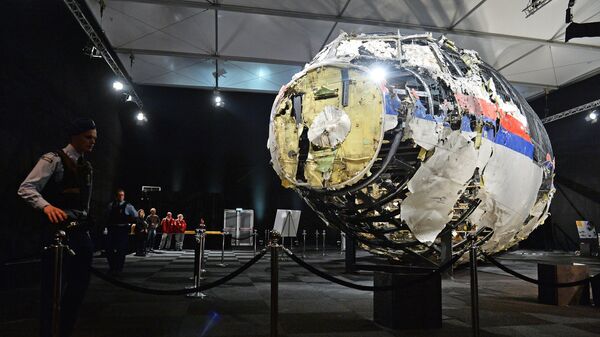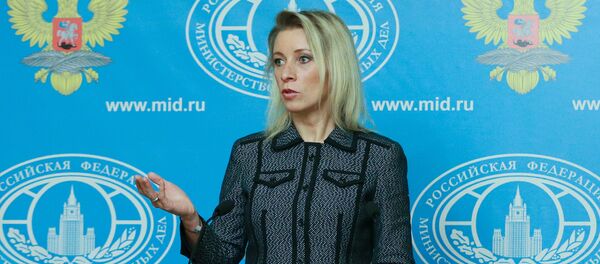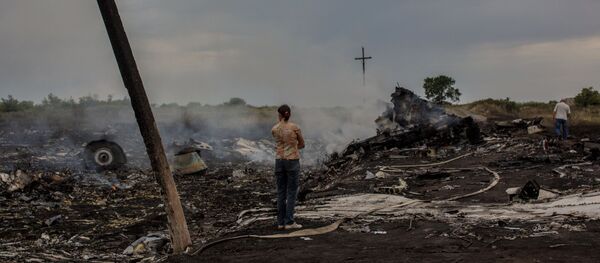"We read the document, and I can state with full responsibility that the Russian commission categorically disagrees with the conclusions in this report, they are fundamentally wrong. The level of irrationality in the report exceeds all limits," Oleg Storchevoy told reporters.
Rosaviatsiya, the national civil aviation regulator said it supports the Dutch Safety Board's conclusion of Ukraine's responsibility for not closing the airspace above conflict-torn Donbas before last year's Malaysia Airlines flight MH17 crash.
"We support the conclusion in the final report that the Ukrainian side bears full responsibility for not closing the airspace amid military activities that could be potentially dangerous for civil aircraft," Rosaviatsia's deputy head Oleg Storchevoy told reporters.
The DSB, the official Dutch body tasked with investigating the July 17, 2014 crash of the Malaysian Boeing 777 over eastern Ukraine, released its final report on Tuesday wrapping up 15 months of inquiries into the detailed of the tragedy.
It was concluded in the reported that the plane seemed to have been struck by a ground-to-air missile, adding that at least 16 military airplanes and helicopters had been shot down in the eastern part of Ukraine several months prior to the MH17 crash.
Dutch investigators bashed Kiev for closing its eyes to apparent threats to civil aviation. It said in the report that Ukrainian authorities believed there was no "sufficient reason" to close the airspace over eastern Ukraine, which was proven to be wrong.
Ukrainian authorities failed to coordinate actions between the country's armed forces and air transportation services prior to the MH17 disaster in conflict-torn Donbas, the deputy head of Rosaviatsiya, the national civil aviation regulator said.
"Ukrainian authorities failed to ensure coordination between military authorities and the authority for air traffic services in order to ensure flight safety over the conflict zone," Oleg Storchevoy told reporters.
The Netherlands gave a single bow-shaped destructive element to Russia as proof that Malaysia Airlines flight MH17 was downed from the eastern Ukrainian town of Snizhne, the deputy head of Rosaviatsiya, the national civil aviation regulator said.
"Back during our first meeting in the Netherlands, a version — an unproved version, actually — was presented to the entire commission, that the aircraft was struck by a Buk-M1 type missile, and that the launch of this rocket was carried out from the town of Snizhne. The evidence presented to support this was a single bow-shaped destructive element that was allegedly found," Oleg Storchevoy told reporters.
"We were told that it was found in the cabin somewhere in the winding insulation," he added.
The authors of the Dutch MH17 report slanted documents on an already chosen version of events, Rosaviatsia's deputy head Oleg Storchevoy said.
"It seems that instead of a sequential analysis of objective data, the commission collected evidence for a pre-invented version," Oleg Storchevoy told reporters.
According to Storchevoy, destructive elements allegedly found on the MH17 crash site were used to push the investigation down a certain path.
"These destructive elements that were supposedly found were probably introduced to ensure the investigation moves in the right direction," he said, noting that real chemical compounds left by Buk missile explosions have nothing in common with the data presented in the Dutch report.
Straight after the plane crash, Washington and its Western allies accused militia forces in eastern Ukraine of shooting it down with a Russia-made missile system. Militia fighters denied the claim, saying that they did not possess weapons capable of bringing down an aircraft flying at 32,000 feet.
According to the Dutch Safety Board’s report, the Malaysian aircraft crashed as a result of a 9N314M-model warhead carried on the 9M38-series of surface-to-air Buk missiles. It was fired from anywhere within a 320 square kilometer (123 square mile) area of eastern Ukraine, the report said, without specifying who was responsible for the launch.
Earlier the same day, Russian air defense systems producer Almaz-Antey presented its own probe into the tragedy, which found that the missile that downed the Malaysian plane could only have been a model of the 9M38-series of missiles that was removed from service in the Russian army in 2011. It also concluded that the missile was launched from the region of Zaroshchenske, which was under the control of Kiev-led forces at the time of the crash.
Russia has repeatedly expressed disappointment that Dutch investigators have not collaborated with Russian specialists.
Russia will use its right to initiate the renewal of the Malaysia Airlines flight MH17 crash investigation, the deputy head of Rosaviatsiya, the national civil aviation regulator said Wednesday.
"Russia will use the standard presented in annex 5.13 to the Convention on International Civil Aviation to initiate the resumption of the disaster investigation," Oleg Storchevoy told reporters, adding that Russia invites any other countries "not indifferent to finding the true cause of the tragedy" to assess Russian findings.
The version that Malaysia Airlines flight MH17 was shot down with a Russian-produced Buk surface-to-air missile system is not final, the deputy head of Rosaviatsiya said.
"You will not hear a final version anywhere that it was a Buk missile that caused the damage. We have been doing research and calculations based on those positions, because we were told in the beginning of the year that the aircraft was struck by a Buk missile. This is why we carried out this research," Oleg Storchevoy told reporters.
He underscored that Russia is not denying any version of events leading to the crash, nor has it pushed any of its own versions so that not to put pressure on the commission investigating the crash.
"We do not refute or deny any versions. We believe that there is a need to conduct further studies to determine what the aircraft was struck by," Storchevoy said.
Computations confirm that if it was, in fact, a Buk missile that downed Malaysia Airlines flight MH17, it could only have been launched from East Ukraine's Zaroshchenske settlement, the deputy head of Rosaviatsiya said.
"Computations were made on a possible flight path and the possible launch site. And if the aircraft was struck by a Buk-type missile, it could only have reached the aircraft if launched from the Zaroshchenske settlement," Oleg Storchevoy told reporters.
The Netherlands denied Russian experts access to the MH17 crash site, limiting the Russian team's participation in the investigation, the deputy head of Rosaviatsiya said.
"We did everything we could to visit the crash site, and such agreements were reached… But we could not leave for the crash site alone… without an official permission or approval from the chairman of the investigative commission," Oleg Storchevoy told reporters.




